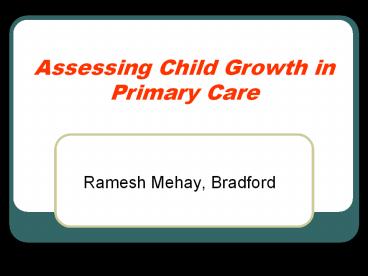Assessing Child Growth in Primary Care - PowerPoint PPT Presentation
1 / 17
Title:
Assessing Child Growth in Primary Care
Description:
There should be no hesitation in referring short children. ... Nail changes ( spooning = turners, renal failure; finger clubbing = ?IBD ) ... – PowerPoint PPT presentation
Number of Views:68
Avg rating:3.0/5.0
Title: Assessing Child Growth in Primary Care
1
Assessing Child Growth in Primary Care
- Ramesh Mehay, Bradford
2
Introduction
- There should be no hesitation in referring short
children. - Children with hormonal deficiencies need
treatment as early as possible - Each year that passes without appropriate
replacement therapy represents some loss in final
adult height.
3
Why are boys taller than girls after Puberty?
- Growth Spurt boys enter this spurt 2 years
later than girls - During 2 year period, boys grow at 5cm/y (10cm
total) girls grow at 8cm/y (16cm total) - Age 14 girls stop growing boys now growing
8cm/ year (16 cm) - Because boys stop growing 2y later, (5cm/year)
they are at least 10cm taller
4
Facts n Figures who is bigger than who?
- Average heights (UK) F 5 4 M 5 9
- lt 11 BG
- 11-14 GgtM
- gt14 BgtG (by around 5)
- Complete fusion
- Girls 16-18 Boys 18-21
5
- A 12 year old girl is referred to you after a
school medical because of concerns about short
stature. How would you assess her
6
Measuring Procedure
- Remove the childs shoes
- Ask him to stand with heals against wall or plate
- As an assistant to hold the feet on the ground,
so that the childs heels do not rise when you
ask him to stretch upwards - Make sure the child is standing straight. Press
the thighs and pelvis gently backwards against
the surface of the wall or measuring device - Ensure that the upper margin of the auditory
meatus is in a line with the angle of the orbit - Stretch the child gently upwards with traction
under the angle of the jaw and ask him to take a
deep breath - Measure with your eye in line with the scale to
avoid parallax errors - Plot on chart
7
Plotting stuff on a chart
- Use charts to assess growth
- Supine length up to age 2 standing height
thereafter - Take 2 measurements in a 12 month period
- Accuracy is the key
- Correct for prematurity
- Plot mid parental height but remember not that
accurate, 0.7 correlation
8
The Assessment Worry or Not?
- HISTORY
- Find out the reasons for parental concern take a
review of systems enquiry gut, heart, chest,
GUS, CNS - A good screening question is the child growing
out of his trousers or shoes - EXAMINATION
- If you suspect short stature look for additional
signs and symptoms (dysmorphic syndromes)
examine for asymmetry, limb or spine shortening,
general appearance (triangular facies and
clinodactyly of Silver-Russell syndrome),
evidence of systematic illness, heart murmurs
(congential heart disease), Nail changes (
spooning turners, renal failure finger
clubbing ?IBD ), early pubertal changes,
webbed neck and wide carrying angle (Turners)
9
- MEASUREMENTS
- Record plot the birthweight and gestation
- Note parental heights plot mid parental height
(expect most children to reach a height at full
growth within 8cm of mid parental height centile)
(MAKE SURE PARENTS DONT HAVE A GROWTH DISORDER) - Get past growth records
- Ascertain past or present illnesses
- Take two measurements to assess growth velocity
(but think about early referral too) - Crossing the centile lines for height is worrying
and usually demands investigations PROVIDING the
measurements are take over 12 months apart
10
Comparing Height Weight
- If WgtH primary growth problem likely
- (familial, genetic, bone dysplasia, syndromal or
hormonal) - If WH primary growth problem possible
- If WltH primary growth problem unlikely
11
Tests
- FBP, UE, creatinine, Ca, Phosphorus, Alk Phos,
TFTs. Skeletal Survey (anthropometry) (latter
child development centres) other lab tests as
per clinical findings - Turners refer for chromosomal analysis
(karyotyping) - GH deficiency refer for provocation test
- X-rays for bone age
12
More Facts n Figures
- At age 4 height birth length x 2
- At age 13 height birth length x 3
- Puberty causes a brief acceleration of the
height velocity (usually 5cm but can be up to
10cm per year)
13
Important Causes of Short Stature
- Short stature height below the 3rd centile
- Genetic familial
- IUGR
- Malnutrition Psychosocial Deprivation
- Endocrine (hypothyroidism, GH deficiency)
- Chronic Diseases
- Chondrodystrophies
14
Whats This?
15
Whats this?
16
Tall Stature
- Usually a rare complaint. Often when parents are
worried about their daughters becoming too tall. - Refer as soon as the problem is presentated
early treatment is essential if the aim is to
reduce the adult height by any significant amount - CAUSES
- Genetic Familial
- Marfans
- Klinefleters
- Thyrotoxicosis
- Growth Hormone Excess
- Precociouc Puberty
17
Excellent resources on
- www.bradfordvts.co.uk
- click online resource gt clinical stuff gt paeds
- Lets look at some charts































